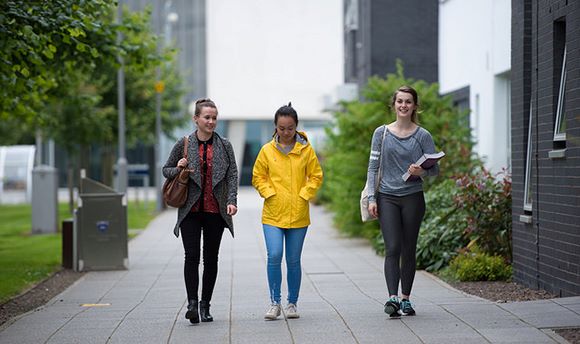Strategic Report
Status
Queen Margaret University, Edinburgh is an autonomous Scottish higher education institution. The University’s governing instruments and arrangements are set out under the Queen Margaret University, Edinburgh (Scotland) Order of Council 2007, amended from 1 October 2019 through the Queen Margaret University, Edinburgh (Scotland) Amendment Order of Council 2019. The 2007 Order is made under section 45 of the Further and Higher Education (Scotland) Act 1992. The University is registered under the Companies Acts as a company limited by guarantee, with its registered office at Queen Margaret University Drive, Musselburgh, East Lothian, EH21 6UU. The University has been entered into the Scottish Charity Register and is entitled, in accordance with section 13(1) of the Charities and Trustee Investment (Scotland) Act 2005, to refer to itself as a Charity registered in Scotland.
Scope of the financial statements
The financial statements presented on pages 18 to 39 comprise the consolidated results of the University and its subsidiary company, QMU Enterprises Limited. QMU Enterprises Limited undertakes commercial consultancy work, utilising the expertise of the University’s academic and technical staff, and also deals with vacation letting of the University’s student accommodation.
The financial statements have been prepared on a going concern basis in accordance with Financial Reporting Standard 102 (FRS 102) and the Statement of Recommended Practice – Accounting for Further and Higher Education 2015 (SORP 2015), with the Accounts Direction issued by the Scottish Funding Council (SFC) and with the United Kingdom Companies Acts.
Development of strategic plan
During 2018/19 the University Court undertook a review of the strategic plan, originally approved in December 2015, which had been developed in accordance with the QM150 strategy, details of which are accessible on the University’s website. The QM150 strategy sets out the mission for the development of the University over a ten year period, culminating in the 150th anniversary of the founding of the institution in 2025. Whilst the University Court concluded that the nine overarching goals contained in the plan, which the University wishes to achieve in order to deliver the strategy by 2025, remain appropriate, it agreed that a fuller review should be undertaken during 2019/20, as set out in the section on future developments below. A key element of the plan remains the inclusion of key performance indicators which the University Court uses to monitor progress towards the achievement of the goals set out in the plan (both financial and non-financial). The plan also sets out the processes employed to manage the risks which might inhibit this achievement.
Results for the year
The Group’s consolidated results for the year to 31 July 2019 are summarised as follows:-
| Area | 2018/19 (£ million) | 2017/18 (£ million) |
|---|---|---|
| Total income | 39.5 | 37.0 |
| Total Expenditure | (45.5) | (42.4) |
| (Deficit) / surplus for the year | (6.0) | (5.4) |
| Actuarial gain /(loss) in respect of pension schemes | (7.4) | (7.6) |
| Unrealised surplus on revaluation of land and buildings | 30.6 | - |
| Total comprehensive income for the year | (17.2) | 2.2 |
The main changes in the underlying outturn position compared to 2017/18 were:-
- An increase in educational contracts of £0.4 million;
- An increase in tuition fees of £0.6 million;
- An increase in the recurrent SFC grant of £0.5 million;
- An increase in staff costs of £2.2 million, £1.1 million of which was due to the transformation exercise, £2.7 million due to pension provision offset by savings made by the transformation exercise and turnover savings;
- An increase in depreciation of £0.6 million due mainly to the revaluation of the main campus in 2017/18;
QMU Enterprises Ltd generated a profit of £347,000 (2017/18: £247,000), which was passed to the University under deed of covenant.
Cash flows and liquidity
The result for the year, adjusted for the effect of non-cash items and interest, was a net cash inflow of £3.7 million on operating activities (2017/18, £3.5 million inflow). Overall cash balances decreased by £0.002 million (2017/18; £0.3 million). Cash balances at 31 July 2019 of £8.1 million (2018: £8.1 million) represented 74 days’ expenditure (2018: 80 days).
Management of principal risks and uncertainties
In common with other universities, Queen Margaret University has to manage its activities whilst facing significant pressures on its funding as well as on its cost base. Significant risks facing the University include:-
- Funding from government through the Scottish Funding Council (SFC), the University’s main source of income, is likely to suffer from further real-terms reductions over the next few years as a consequence of spending cuts throughout the public sector.
- Recruitment of international students continues to be challenging, largely as a result of difficulties faced by international students in obtaining visas to study in the UK, although this may be mitigated to some extent by the recent decision by the UK Government to reinstate the post-study work visa.
- Underlying assumptions contained in the future financial forecasts include an assumption that income from tuition fees and education contracts will increase significantly over the next three years. A review of the University’s academic portfolio took place during 2017, which provides an indication that there is scope for the University to increase its income in this area, and progress will continue to be monitored carefully, with possible mitigating actions being planned for in the event that the increase in income is not achieved.
- Pressure on staff costs continues to build, both in terms of pay awards (where the University continues to participate in the UK-wide national negotiating framework) and also in terms of the cost of employers’ pension contributions.
- The full implications of the decision for the UK to leave the European Union are still unclear. However, it is likely that this will have an adverse impact on engagement with both students and staff from EU member states, and will introduce additional hurdles in accessing EU funding for research and other activities.
The identification and management of risks is firmly embedded within the University’s structure and processes. The institutional corporate risk register, which includes a description of actions undertaken to mitigate risks, is formally reviewed by the Executive Board and the Audit & Risk Committee as well as being discussed by the University Court. The Court also undertakes, from time to time, an exercise to agree its appetite for risk, and to ensure that residual risks, after the application of mitigating actions, sit within the agreed tolerance.
Financial sustainability and going concern
The University Court has made an assessment of a particular risk around the financial sustainability of the University. Having anticipated that the University was likely to breach the terms of a bank loan covenant measured against the 2018/19 financial statements, University management approached Barclays Bank plc, which provided a letter of variation confirming that it would not measure the particular covenant in respect of the year ended 31 July 2019, and that the measurement of this covenant would be varied in the subsequent three financial years, such that compliance with the covenant will be achieved so long as the University meets its financial forecasts.
In accordance with the recommendations from the Higher Education Financial Sustainability Strategy Group (FSSG), the University Court undertakes a formal annual assessment of the University’s financial sustainability. This process involves reviewing a common set of financial indicators, which have been applied to the University’s historical results and to the financial forecasts measured over a rolling five-year period, so as to reduce the impact of any one-off exceptional items arising in any year. The two key indicators which the University Court has agreed to focus upon to inform its considerations around financial sustainability are:-
1. Earnings before interest, taxation, depreciation and amortisation (EBITDA); and
2. Net cash flow from operating activities less interest payable as a percentage of turnover.
The second indicator has been adapted from the basket of financial indicators recommended by the FSSG as it is a more appropriate measure for the University, given its relatively high level of borrowings as a proportion of its turnover. The targets are also set at a level which will allow compliance with banking covenants. The results of the annual review undertaken in November 2019, based on a rolling five-year period, were as follows:-
| Indicator | Target | Average |
|---|---|---|
| EBITDA | 12% | 11.2% |
| Net cash flow from operating activities less interest payable as a percentage of turnover | 6% | 8.5% |
The University Court has also undertaken an assessment of going concern and liquidity risk, taking into account the principles and recommendations set out in the Sharman report into going concern and liquidity risks, as well as the key performance indicators used to measure financial sustainability set out above, and the letter of variation of covenant received from Barclays Bank plc. As a result of this exercise, the University Court has a reasonable expectation that the University has adequate resources to enable it to continue in operational existence for the foreseeable future, and that it is appropriate to adopt the going concern basis of accounting in preparing the annual financial statements.
Borrowings
Borrowings at 31 July 2019 amounted to £30.6 million, (31 July 2018, £32.1 million) relating entirely to a secured loan facility with Barclays Bank plc taken out to fund the campus development at Musselburgh.
Pension arrangements
The University is involved in three pension schemes, as follows:-
The Lothian Pension Fund, which is part of the Local Government Pension Scheme (LGPS), is a multi-employer defined benefit scheme. The scheme had a deficit at 31 July 2019. The Fund trustees have, in recent years, applied increases to the level of employers’ and employees’ contributions to the scheme in order to recover this deficit position. The University’s share of the fund deficit, as calculated by the scheme actuary, has been shown as a liability at 31 July 2019.
The most recent actuarial review of the Scottish Teachers’ Superannuation Scheme (STSS) was undertaken as at 31 March 2016.
As a result of this review, the level of employers’ contribution to this scheme was increased from 17.2% to 23.0% with effect from 1 September 2019. The valuation identified a notional shortfall of £1.3 billion, which is being repaid by a supplementary rate of 4.3% of employers’ pension contributions over a 15-year period from 1 April 2019. This contribution is included in the 23.0% employers’ contribution rate.
The Universities Superannuation Scheme is a hybrid pension scheme, providing defined benefits (for all members), as well as defined contribution benefits. The assets of the scheme are held in a separate trustee-administered fund. Because of the mutual nature of the scheme, the assets are not attributed to individual institutions and a scheme-wide contribution rate is set. The University is therefore exposed to actuarial risks associated with other institutions’ employees and is unable to identify its share of the underlying assets and liabilities of the scheme on a consistent and reasonable basis. As required by Section 28 of FRS 102 (Employee Benefits), the University therefore accounts for the scheme as if it were a wholly defined contribution scheme. As a result, the amount charged to the income and expenditure account represents the contributions payable to the scheme in respect of the accounting period. Since the University has entered into an agreement (the Recovery Plan) that determines how each employer within the scheme will fund the overall deficit, the University recognises a liability for the contributions payable that arise from the agreement (to the extent that they relate to the deficit) and therefore an expense is recognised in the income and expenditure account.
Social inclusion
Queen Margaret University aims to promote entry to, and provide education at, undergraduate and postgraduate level to a diverse range of students, whatever their background. In assessing candidates for admission to the University, we are committed to the principles of fairness, transparency, and widening participation. Our Contextual Admissions Policy commits to making offers to identified groups where we recognise that a range of factors may have impacted on attainment. We offer a range of recruitment, outreach, pre and post entry activities to raise aspiration, encourage access and maximise retention from under-represented groups in line with our Student Experience strategy, Mainstreaming Report and Equality Outcomes, and underpinned by the University’s Outcome Agreement with the Scottish Funding Council.
Student satisfaction
The University has participated in the National Student Survey (NSS) since 2010. The 2019 institutional results showed an overall satisfaction score of 82.3%, the same as in 2018. Particular highlights were increases in Learning Resources (up 4.7%), Assessment and Feedback (up 4.3%), Academic Support (up 3.9%) and Student Voice (up 3.4%).
Graduate employment
Our Employability Strategy brings together in a single document our approach to employability, with the primary objective of providing equitable employment and careers education to all students and graduates, and providing a public statement of our commitment to their success. We consider that our efforts are proving highly effective. Our HESA performance indicator for graduates entering employment or further study six months after graduation is 97.1%, which places us joint third in Scotland and joint 14th in the UK for this national indicator.
Student involvement
The University seeks to take account of the views of the student body. The Student President and Vice-President are full members of the University Court and the Senate. Under amended governance arrangements introduced in 2018-19, student membership on Senate increased to four, or 10% of the total membership. There is student representation on all other major committees of the University. Senior members of staff, including the Principal, engage with the Students’ Union from time to time to explain aspects of the University’s operations and plans and to answer questions from student representatives. The Deputy Principal, University Secretary and the SU Sabbatical Officers meet regularly as the Student Union Partnership Board to discuss issues of common concern and interest, and a Student Partnership Agreement has been put in place between the University and the Students’ Union. The University also provides an annual grant to the Students’ Union.
Environmental issues
The University has one of the “greenest” campuses in the UK, which received a BREEAM “excellent” rating. Sustainability remains at the heart of the University’s activities, which has been recognised through a number of green awards.
Future developments
In order to address the risks set out above, and also to take advantage of further opportunities as they arise, the University is continuing to focus on ensuring that its academic, infrastructure, human resources and financial strategies are closely aligned. A review of the academic portfolio has been undertaken, the results of which continue to be used to ensure that the University is able to achieve the objectives set out in its strategic plan, which will allow the University to continue to generate an adequate level of cash in the short to medium term and to maintain an adequate level of reserves. The Court carries out regular monitoring of the University’s financial sustainability, as described above.
The likely impact of the UK’s exit from the European Union on the University’s operations and financial plans remains uncertain. The University has identified a number of elements which it will require to monitor as the Brexit negotiations continue. These include:-
- the impact on tuition fees from EU students (and any consequential impact on EU student numbers choosing to study at Queen Margaret University);
- the ability to access research and other funding from EU institutions;
- the status of staff from within the remaining EU (and the University’s ability to attract and retain such individuals); and
- the attractiveness of the University as a partner institution for collaborative work with Universities based in the remaining EU.
The funding environment for Scottish higher education institutions remains challenging, as the level of funds available to the Scottish Government and the Scottish Funding Council (and therefore the amount available for distribution to universities) continues to decline in real terms. The financial challenges facing the University are highlighted in the financial sustainability indicators set out above, and in particular the EBITDA indicator, for which the five-year average remains below the target level. The long term financial health of the University will continue to depend upon its ability to grow and diversify its income base, and to control costs. In order to facilitate this, the new Principal is leading a review of the University’s current strategic plan, with a view to providing additional focus for the University’s activities whilst at the same time creating an environment which will allow the development of further new and increased sources of income, as signalled through the review of the academic portfolio, to take place.
On behalf of the University Court
Dr Frances Dow, CBE
Chair
27 November 2019



